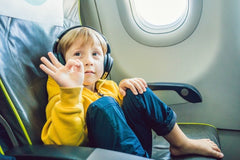
A Little Planning Goes a Long Way
Holidays are the busiest time of the year to travel by plane. Preparing a child, teenager or adult with autism spectrum disorder for plane travel, including all those new security techniques used at airport security checkpoints, can make a huge difference in making holiday travel a more enjoyable experience for all involved.

Use these tips to help your family plan for a successful air travel experience. It is important to remember that children diagnosed with ASD vary in terms of abilities and preferences, and not all recommendations may suit every child.
BEFORE THE FLIGHT

- Create a social story:
-
Plan:

- Provide the airline with advanced information:
PACK

Packing the right items to support your child’s needs can make a world of difference when traveling.
- Don’t forget to pack necessary coping or treatment items in your carry-on bag, like a change of clothes and medicines.
- Bring items to keep your child entertained. Be sure to pack your child’s favorite toys, books, snacks, headphones and plane-safe electronics. Keep in mind that there will be times when electronics may not be used on the plane.
- Have contingency plans for possible flight delays.
AIRPORT SECURITY

- Accommodations: To accommodate travelers with disabilities, the Transportation Security Administration (TSA) has established a protocols that allows for special accommodations.
Many airports and airlines have supportive resources and staff. Don’t hesitate to ask for the help you need.
- Learn where you can find resources at the airport, such as customer assistance desks, quiet rooms, family-friendly bathrooms and sensory-friendly rooms.
- There are many support staff within the airport to assist your family. Ask for support or accommodations if and when you need them.
ON THE AIRPLANE

- Boarding:
- Ear-popping.
- Watching the time.
- In-flight entertainment.

Allow your child access to items in their travel bag. Allow your child to have access to DVDs, iPods, books, coloring books, toys, etc. If your child enjoys tactile stimulation, they may benefit from playing with play dough or putty while on the airplane.

Traveling with a child who has autism might pose some challenges, but those challenges can be overcome. With a little preparation and planning, you and your child can take a trip that is not only safe, but enjoyable too.










1 comment
thank you, this would help me . my son will travel 18hrs , and his first time to travel that long travel.
Leave a comment